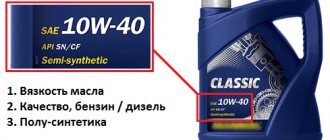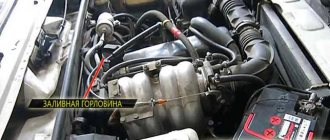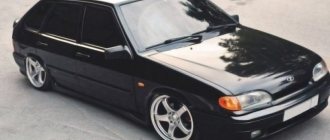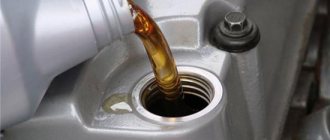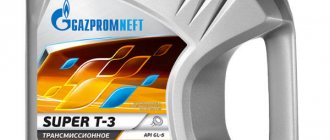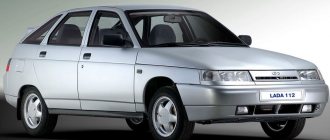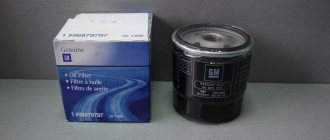Description of the engine lubrication system. 417
Oil radiator
- Do you need an oil cooler? For what?
- Is the oil cooler valve leaking?
- Automatic oil cooler on/off
Oil pump
- Oil pump and pressure in the oil system
- Selection and tuning of the oil pump
Other questions
- What oil should I use? Advice, opinions, practice
- Oil change, frequency, tips
- How to correctly measure the oil level?
- Oil contamination sensor
- How to prepare flushing oil
- Is it always necessary to flush the engine when changing the oil?
- What is normal oil pressure?
- Oil pressure goes through the roof... Why?
- About the lubrication system of old engines
- Replacing valve stem seals
- Useful information about Goetze valve stem seals
- Oil filter selection
- Where does the oil on the fuel pump lever come from?
- After draining the old oil and then adding new oil, there is no pressure. Why?
Maintenance of UAZ vehicles
In order for the car to serve faithfully for many years, it is necessary to perform timely maintenance of the car. Any prudent car owner should know the above data on refueling volumes by heart.
Service centers often employ incompetent personnel, and the cost of their services is unreasonably high. Therefore, the best solution would be to do the maintenance of the machine yourself. To do this, you need to know not only the filling volumes, but also the timing of replacement of lubricants and liquids.
For example, let's say you're the proud owner of a manual-transmission Patriot. This car requires servicing once a year or every 7,000 km. To carry out maintenance on your own, you will need to replace the lubricants in the internal combustion engine, manual transmission, manual transmission, axles, as well as oil and fuel filters if necessary.
There is quite a lot of work to be done. First you need to change the engine oil in the engine and change the fuel filter. The replacement process takes place on a warm machine - it’s faster and more efficient.
The algorithm of actions is as follows:
- The filler and drain plugs are unscrewed. Hot oil is poured into a container.
- Use a wrench to remove the oil filter.
- The drain plug is lubricated with sealant and screwed into place.
- A new filter is being installed.
- The filler plug is screwed in.
It is important to note that when changing the type of oil, after draining the waste, flushing fluid is added. Otherwise, there is a risk of engine failure.
To carry out maintenance correctly, you need to know how much oil you need to pour into your car. The fact is that the volume of oil in the UAZ Patriot engine depends on the type of fuel. A gasoline engine will need to be filled with 7 liters, a diesel engine will need to be filled with 6.5.
After the internal combustion engine, we move on to the manual transmission and manual transmission. Transmission lubricant is also drained from a heated car. In principle, the algorithm for changing the lubricant on the gearbox and transfer case is similar to that presented above.
The same lubricant is used for manual transmissions and manual transmissions. The required volume will be about 5 liters of liquid. It is advisable to choose a lubricant with high viscosity, this will ensure uninterrupted operation of the car at low temperatures.
Changing the oil in axles occurs only after preliminary cleaning of the surfaces around the filler and drain holes. If this procedure is not followed, dust particles and metal shavings will enter the system. The plugs also need cleaning. The lubricant itself is filled with a syringe until the system overflows.
So, having completed the work listed above, you will spend about three hours of your time. At the same time, you will save money on the services of the service center, and most importantly, you will know that the service was performed efficiently and the vehicle is insured against unwanted breakdowns.
UAZ 452 filling volumes
Let's answer questions related to pouring oil into various components and assemblies of the UAZ Bukhanka vehicle.
How much oil is poured into the engine of the UAZ Bukhanka? For good engine performance, it is recommended to fill up to 7 liters of semi-synthetic motor oil. Viscosity grade - 10W-40.
When adding oil, check its level with a dipstick. An oil change is carried out every 10,000 kilometers or once a year .
Up to 1 liter of synthetic transmission oil with a viscosity grade of 75W-90 standard GL-4 is poured into the gearbox . Replacement is carried out every 45,000 kilometers of the vehicle.
0.7 liters of oil similar to gearbox oil is poured into the “Loaf” transfer case. Replace at 45,000 kilometers.
Mineral hypoid oil (GL-5) with a viscosity of 80W-90 of 0.85 liters is poured into the gearboxes of the front and rear axles . Change oil every 45,000 kilometers .
Please note that the replacement frequency should be selected based not only on the timing and mileage specified in the recommendations, but also on the condition of the vehicle and its operating conditions.
List of recommended lubricants, working fluids and substitutes for UAZ
Lubricants
- motor oil
M-8-V, GOST 10541-78 or M-6z/10-V (DV-ASZp-10V) OST 38.01370-84. Northern automobile oil M4z/6V1 OST 38.01370-84. - transmission oil
TSp-15K GOST 23652-79. Substitute: automotive transmission oil TAP-15V or TAD-17I OST 23652-79. At temperatures below minus 20 °C, automotive transmission oil TSp-10 GOST 23652-79. - Lubricant
"Litol-24" GOST 21150-87, "Lita" TU 38.1011308-90 or "Litol-24RK" (grease SHRUS-4 - an analogue of "Litol" with the addition of molybdenum disulfide and other additives that reduce wear) - Graphite lubricant
USSA GOST 3333-80. - Grease
CIATIM 201 GOST 6267-74, CIATIM-221 GOST 9433-80.
Working fluids
- Coolant
TOSOL-A40M, TOSOL-A65M TU 6-02-751-86 (use in winter OZH-40, OZH-65 GOST 28084-89 is allowed) or “Lena-40”, “Lena-65” TU 113- 12-11.104-88. Water is clean and “soft” (rain, snow, boiled). - Shock absorption fluid
AZh-12T GOST 23008-78. Substitute: spindle oil AU OST 38.01.412-86. - Brake fluid
“Tom” TU 6-01-1276-82, “Rosa” TU 6-55-37-90, “Neva” TU 6-01-1163-78, GTZh-22 TU 6-01787-75 (see . also opinions about different brake fluids) - Electrolyte
with density, gf/cm3: 1.25 – for areas with temperatures up to -10 °C; 1.27 – for areas with temperatures up to -30 °C; 1.29 – for areas with temperatures up to -40 ° C (see also the article “Battery”) - Gasoline
A-76 GOST 2084-77, summer or winter grades.
Refueling data for wagon-type vehicles
* It is possible to install only the main tank ** Including starting heater Engine 417 mod., 4-speed gearbox top
Gas distribution mechanism
In 2010
At the Ulyanovsk plant, the gasoline engine underwent the process of modernizing
the gas distribution mechanism
. As a result, this affected the configuration of the camshaft cam profile, which contributed to an increase in valve stroke by one mm. These innovations were needed to improve the stable operation of the unit at idle, as well as to meet the standards and requirements of the Euro-3 standard.
The valve springs did not undergo changes at the same time, and this situation led to the fact that the acting force on the springs crossed the norm, now being equal to 180 kgf. During the process of installing a regular set of rods on a new engine, until the engine was warmed up, knocking noises from the hydraulic compensators were heard.
To be able to prevent this problem, you should change the spring force by dismantling the internal valve springs.
Replacement procedure
Before starting the oil change procedure, you need to decide what type of oil you will pour into your engine. If the engine was previously filled with mineral water, under no circumstances should you fill in synthetic motor oil without first flushing the engine. The opposite is also true; when switching from synthetic oil to mineral oil, it is also necessary to flush the engine, since these oils are not compatible with each other.
An unpredictable reaction may occur, as a result of which flakes may form in the engine lubrication system, which consists of many small-diameter passages, which will clog the oil passages and cause the engine to seize. But semi-synthetic oil is equally compatible with both mineral water and synthetics, so in this case you can do without flushing the engine.
Many car enthusiasts do not trust flushes, especially the so-called “five-minute” flushes (when a special liquid is poured into the old oil for 5 minutes of engine operation, then it is all drained), since it is impossible to completely drain the flushing fluid; any part of it will remain in one way or another in the engine and will degrade the lubricating properties of the new oil.
Therefore, you need to treat flushes with special caution, use them only when it is really necessary - when changing types of oils, or if you bought a car second-hand and you don’t know what kind of oil is poured into it. To replace, you will need: new engine oil and filter, a clean rag, a container for drained oil with a capacity of 5 liters, a 17mm wrench, a screwdriver (or a special wrench for unscrewing the oil filter).
Engine ignition installation
An ignition device used in a power plant, a product without which the operation of the engine is impossible. The correct operation of the engine and the combustion of the fuel charge are directly related to how to install the ignition on the UAZ 421 engine. Since hydraulic valve compensators are not structurally provided, manual adjustment is carried out, providing:
- Installation of the shaft in accordance with the advance angle of five degrees. Align the middle marking of the friction wheel with the influx of the core plug on the compression in chamber “1”;
- Find out the compression stroke of the chamber “1” by removing the plug. In this case, the slider is located against the inner contact surface of the plug, connected by a conductor to the spark plug of chamber “1”. An alternative definition based on the candle in chamber “1” involves dismantling the product. The resulting void is closed with a paper plug, and then the shaft is turned. On the compression stroke, the plug will come out of the hole;
- Using the “tenth” key, slightly unscrew the octane regulator;
- Set the octane regulator calibration to “0”, corresponding to the middle of the calibration;
- Using the “tenth” key, slightly release the octane regulator plates;
- Align the rotor mark (red marker) with the stator arrow by turning the distribution sensor frame. Fix the location by tightening the fasteners;
- Check the position of the slider (against the contact of the plug of the 1st chamber), check the correct connection of the conductors leading to the chambers. The countdown starts from camera “1”, counterclockwise, in the order “1st, 2nd, 4th, 3rd”.
The ignition operation must be additionally monitored while driving the vehicle. Briefly press the foot speed lever to full speed, having previously accelerated the car to a speed of 60 kilometers per hour. Detonation for 1-3 seconds indicates that the settings are correct. Longer - the advance angle is exceeded, no detonation - the advance angle is insufficient. In the last two cases, the setting is repeated.
How to change the oil in a UAZ Bukhanka engine with your own hands?
In order for the UAZ Bukhanka car to serve properly for many years, drivers need to regularly undergo technical inspections and also replace consumable parts. Mandatory procedures include changing the engine oil.
The process fluid performs the following functions:
- provides the necessary pressure force;
- effectively lubricates the surfaces of spare parts and prevents their wear;
- removes dirt and prevents blockages in the mechanism;
- regulates normal temperature.
After 70 thousand kilometers, the fluid must be replaced.
It is also recommended to replace the oil filter together with the engine oil. The driver can do this work independently. The following tools will be required:
- Motor fluid of the required viscosity and in sufficient volume. In order to determine what product needs to be poured into the UAZ Bukhanka, you should look at the technical documentation of the vehicle;
- New oil filter;
- A set of standard socket and chisel keys;
- Funnel;
- Empty container for draining waste;
- Clean rags.
Engine Description
The UAZ-421 engine has been produced at the plant in Ulyanovsk since 1993. The motor is used for installation on UAZ cars: “469”, “Bukhanka”, “Bars”, “31519”, “Hunter”, etc. The designers decided to replace the outdated “417” unit with a motor, introducing new trends into it.
Thus, an original design of an aluminum frame was used, in which dry liners with thin, cast-iron walls are filled. This made it possible to increase the cross-section of the chambers to 100mm, and leave the same size between the cylinders, 116mm. The solution had a positive effect on the service life of the unit, since rigidity increased and the tendency of the cylinders to become “oval” during operation decreased.
The changes affected the piston; the distance between the bottom of the displacer and the pin axis was reduced by 7.5 mm, which reduced the weight of the product. In addition, the length of the connecting rod has increased by 7 mm, reducing the force on the side surface.
Since the distance between the axes of the chambers remained unchanged, most of the components of the “417” and “421” power plants remained mutually interchangeable. The unification affected the cylinder heads, part of the chamber volume was transferred to the piston bottom, in the form of a cone. This increased the volume of the combustion chamber by 12 cm3.
The engine uses a disposable oil filter element, borrowed from the VAZ-2101. The rear crankshaft oil seal is made as a full rubber seal, rather than stuffed with cord.
The negative aspects of the UAZ-421 engine are insufficient quality of components, and increased fuel consumption. Fitting causes frequent leaks of liquids, and surface treatment affects the resource and potential of the unit.
Crankcase ventilation
The motor is equipped with a closed crankcase cavity ventilation system. Part of the gases passing through the compression rings is discharged into the intake manifold using a combined method. The work of the accounting software complex is carried out due to the pressure difference between the crankcase and the intake tract. Just when the 4216 engine is running at high loads, the gases are vented through a special huge branch.
The small branch removes gases when the unit is running at idle speed and at low loads.
Site about off-road vehicles, SUVs, off-road vehicles
The lubrication system of UAZ-3741, UAZ-3962, UAZ-3909, UAZ-2206, UAZ-3303 vehicles with carburetor engines UMZ-4178, UMZ-4179, UMZ-4218, ZMZ-4021 and ZMZ-4104 is combined; parts are lubricated under pressure and splashing.
Lubrication system for UAZ-3741, UAZ-3962, UAZ-3909, UAZ-2206, UAZ-3303 with UMZ and ZMZ engines.
The lubrication system of UMZ and ZMZ engines consists of an oil pump, an oil receiver, oil channels, a full-flow oil filter, an oil cooler, an oil sump, an oil level indicator and an oil filler neck. The capacity of the lubrication system, excluding the volume of the oil cooler, is 5.8 liters. If there is a malfunction in the lubrication system, engine operation must be stopped immediately.
An oil cooler is provided in the lubrication system to cool the oil. When the air temperature is above +20 degrees and regardless of the air temperature, when driving in difficult conditions, with a heavy load and high engine speed, it is necessary to turn on the oil cooler.
Diagram of the lubrication system for UMZ-4178, UMZ-4179, UMZ-4218 engines.
Diagram of the lubrication and crankcase ventilation system of the ZMZ-4021 and ZMZ-4104 engines.
Oil sump.
Steel, attached to the bottom plane of the block with studs. When carrying out repair work, it is necessary to keep in mind that the left front pin screwed into the timing gear cover is special. It is screwed in to a shallow depth so as not to jam the camshaft gear. The crankcase flange is sealed with rubber-cork gaskets.
Advantages and disadvantages
The disadvantages include the attachments - the complex design of a two-chamber carburetor and the low resource of the pump impeller made of polymer material. Due to the use of an asbestos cylinder head gasket, antifreeze often penetrates into the cylinders. Due to strong vibrations, the cylinder head nuts and covers spontaneously unscrew and oil leaks occur.
That is why the manual contains maintenance operations for periodically tightening the nuts and adjusting the valve clearance with your own hands.
On the other hand, the advantages of the design of the ICE 417 and all its modifications are:
- reliable, albeit obsolete, gas distribution system;
- high reliability and service life;
- reduction of owner costs when using low octane gasoline;
- independent overhaul and mechanical boost.
Unfortunately, tuning can add power within 30 hp. With. without installing a turbine.
Ash content
This parameter determines the amount of metal-containing additives, in other words, the amount of ash that remains after complete burning (evaporation) of the oil. Oils are full-ash - with a full package of additives, this is indicated on the canister as Full Saps, or according to the ACEA classification: A1, B1; A3,B3; A3, B4; A5, B5.
Medium ash oils (reduced additive package) are designated on the canister as MID SAPS, or according to ACEA: C2/C3. Low-ash oils have an even smaller additive package; they are designated as Low SAPS or ACEA C1/C4.
Why is ash content reduced? High sulphate ash content is not allowed in most modern cars due to European exhaust emission standards. Such oils are less likely to clog particulate filters and catalysts, and are also less likely to deposit on pistons and rings.
The UAZ Hunter uses engines that are simple in design, so you can safely use medium-ash and even full-ash oils if you don’t want to overpay.
List of internal combustion engine modifications
Traditionally, for the Ulyanovsk Motor Plant, management develops motors in series. The main engine was 4218.10 with Euro-1 characteristics, power 98 hp. s., compression ratio 7 units. The UMZ 421 engine family includes several modifications:
- 4218.10-10 – carburetor, to adapt to AI-92 gasoline, the compression ratio is increased to 8.2, power is increased to 103 hp. With.;
- 421.10 – carburetor, new exhaust tract design;
- 421.10-30 – carburetor, exhaust manifold of a different design;
- 4213.10-40 – injector for UAZ, Euro-3, power 117 hp. With.;
- 4213.10-50 – injector for UAZ, Euro-4;
- 4215.10-10 – carburetor for A-76;
- 4215.10-30 – carburetor, for AI-92;
- 4216.10 – injection, for AI-92 for Gazelles, Euro-3, compression ratio 8.8, power 123 hp. With.;
- 42164.10 – injector for Gazelle, power 99 l. With.;
- 42164.10 – injection, for Gazelle, Euro-4, power 125 hp. p., new camshaft;
- 421647.10 – gas-gasoline version with a capacity of 100 hp. With.;
- 42167.10 – gas-gasoline version with a capacity of 123 hp. With.
UMZ 4213.10
UMZ 4215.10
UMZ 4216.10
Gasoline UMZ 421647.10
A distinctive feature of the 421 motor family is the availability of the 4219 variant for military equipment. Depending on what attachments are used in the internal combustion engine configuration, there are several options for 4219.10:
- 4179.10-01 – for a 254 mm lever type clutch;
- 4179.10-13 – power steering added;
- 4179.10-05 – for diaphragm clutch with a diameter of 240 mm;
- 4179.10-25 – power steering pump added.
Military version 4219.10
The motors have the same volumes; the goal here was not to increase power. A nuance is the presence of a starting heater, a G-250 generator, a fine gasoline filter and shielding of the R-132 sensor and high-voltage equipment ordered by the RF Ministry of Defense.
Malfunctions
| FAULT | CAUSE |
| Detonation and a noticeable loss of engine power appear. | A common cause of such problems is the valve mechanism, which, due to the lack of hydraulic compensators, requires adjustment of the clearances. Also, problems with tripping and detonation can arise due to a failed spark plug that does not produce a spark. |
| The engine runs unevenly, gradually losing oil. | The mediocre thermal stability of the UMZ 421 has become one of the weak points of this power unit. This problem is also typical for UMZ 341 series motors. Oil can leak into the coolant through numerous microcracks in the cylinder head. |
| Repair of UMZ 341 and 421 engines in this case is high cost and consists of replacing the damaged cylinder head. | |
| With a small number of cracks, it is possible to grind the head and use repair gaskets, however, such repairs can only be considered temporary, since after 10-15 thousand mileage problems with oil loss will reappear. | |
| Piston burnout. | An UMZ engine can have similar problems after driving for more than 200-300 thousand kilometers or when operating the vehicle under heavy load conditions. The repair consists of replacing the pistons, crankshaft and cylinder jacket. |
| Significant increase in fuel consumption and loss of traction. | There could be a lot of reasons for this. Starting from problems with ignition in the UMZ 421, and those related to improper operation of the fuel supply system. Repair is possible only after opening the motor and determining the cause of the breakdown. |
| The appearance of oil drips on engines of the UMZ 421 series. | The problem is solved by replacing the cylinder head gasket, which can quickly fail and leak oil. |
| It is much worse if the UMP engine leaks after the engine overheats, which may indicate damage to the cylinder head. In this case, the repair consists of replacing the cracked head. | |
| Motors of the UMZ 421 series start poorly and choke during operation. | Repairs are made after diagnosing the cause of the problems. Quite often it is enough to replace or clean the air filter, which solves the existing problem. The air flow meter may also fail, requiring replacement of the damaged element. |
| The appearance of progressive vibration and trembling of the engine. | The problem lies in a failed engine mount, which leads to increased vibration. |
| The repair presents certain difficulties, since it is necessary to remove the UMP engine from the engine compartment and replace the damaged motor mount. |

